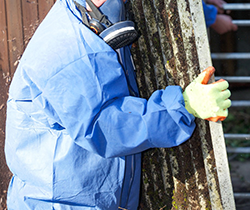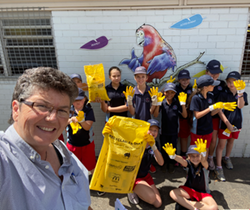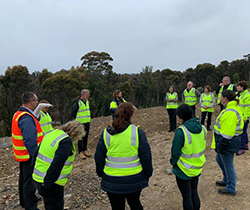News Round
Welcome to our marketplace of news snippets including grants, consultations and events.

A new website on asbestos safety is launched
Environmental awareness events take off
The EPA rallied behind two important awareness causes in November – National Recycling Week (7 -15 November) and Asbestos Awareness Week (23-29 November).
Our asbestos team has also launched a new informative website with insights, instructions and helpful advice for renovators, home owners, tradies and industry and the public during Asbestos Awareness Week.
Statewide forums for EPA stakeholders
The EPA is striving to engage more, be more approachable and provide increased opportunities for two-way communication with stakeholders across NSW.
In February and March next year our Senior Executive will hold 12 forums in key locations across the state to speak with, and listen to local councils and licensees to get a better understanding of their needs, where we can provide support, local issues and how we can best work better together to achieve positive environmental outcomes. During the forum we will:
- provide information on the EPAs strategic direction, discuss our new regulatory strategy, key priorities and new initiatives
- listen and have honest conversations with attendees, including providing an opportunity to answer questions
- discuss local environmental topics and issues, current or emerging.
Further details will be provided soon.
EPA sponsors local government environment award
Our CEO Tracy Mackey joined with War on Waste’s maestro Craig Reucassel and Scott Phillips to present the Local Government Excellence in the Environment Awards in October. The EPA sponsored the Behaviour Change in Waste category award and winners were Muswellbrook Shire Council, Forbes Shire Council, Lane Cove Council, Northern Beaches Council and Waverley Council.

Award winners Julie Rogers and Lucas Heights Community School
Environmental educators come together for sustainability
The EPA is a proud corporate member of the NSW Chapter of the Australian Environmental Educators Association and caught up with them after their annual awards.
Even though Covid restrictions moved the forums online, 350 delegates still came together across four afternoons for the Sustainable Schools NSW Online Conference in October to dive into the topics of sustainability and wellbeing, kitchen gardens and outdoor education, sustainability action planning and grants and waste, recycling and composting.
Winners of this year’s NSW Environmental Education Award winners included Julie Rogers from Lucas Heights Community School for the Return and Earn Award and environment colleague Julia Strykowski, NSW National Parks and Wildlife Service for Government Educator of the Year.
Read more about the award winners and highly commended nominees.
EPA commits to investigating coal ash dam impact
The EPA recently appeared a Parliamentary Inquiry into the remediation of coal ash dams, alongside the Department of Planning, and answered wide-ranging questions from the Committee, and we are now awaiting the Inquiry report and any findings, expected in early 2021.
At the hearing we acknowledged there are community concerns about coal ash dams and we committed to an investigation into potential environmental impacts from the Lake Macquarie coal ash dam. This will be a comprehensive study of surface water and groundwater around the power stations and their potential impacts on the surrounding environment.
The EPA has its own in-house experts on water quality and water pollution, and we also work with scientific experts from the broader Department of Planning Industry and Environment cluster.
This work follows a recent, comprehensive review of air emissions monitoring data and licensing requirements for all coal fired power stations in NSW, tightening limits and strengthening monitoring and reporting requirements.

The EPA Board visiting facilities in southern NSW
EPA Board visits operations in southern NSW
Newly appointed EPA Board Chair Rayne de Gruchy and board members travelled to the Illawarra and Bateman Bay area in November to visit key environmental sites and hear about local environmental issues.
Chairing her first Board meeting Rayne said the EPA played a vital role in protecting the community and the environment and had its sights clearly set on ensuring not only that polluters were held to account, but also to influence business, government and the community on the right kinds of behaviours to not only protect, but to enhance the natural environment.
"This trip also proved a wonderful opportunity to spend time with the staff and board members. It was an action packed trip and provided the Board with valuable insights into the EPA's work and regulatory oversight in forestry and waste and to hear from staff on the ground about their unique local challenges," Rayne said.
"It was clear the community is concerned about seeing the right balance achieved between protecting the environment, and economic sustainability and jobs."
The group also visited the Waste and Recycling Facility at Batemans Bay, South Brooman State Forest, Veolia Woodlawn waste logistics and processing facility at Tarago and Bluescope Steel in Wollongong.

The Premier recognised EPA staff for their bushfire response
Premier’s citations for bushfire response and recovery efforts
The Premier has awarded NSW Bushfire Emergency Citations to 68 EPA staff who, in the course of the Black Summer 2019/2010 bushfires, played a significant role in the emergency response effort.
They spent more than 21,000 hours deployed in incident management, impact assessment, regional recovery and emergency centres and at the Rural Fire Service State Operations facility at Olympic Park, and at the EPA’s incident management centre.
We’re going carbon neutral!
The EPA has committed to becoming a carbon neutral organisation by 2030.
To be considered carbon neutral, an organistion must reduce its carbon footprint to zero by balancing carbon dioxide emissions with carbon removal, often through carbon offsetting, or by simply eliminating carbon dioxide emissions altogether. The EPA already oversees a number of programs across industry and in the community that help manages emissions, particularly through the diversion of organics from landfill, the support of resource recovery initiatives, reducing the reliance on virgin resources, and the capture of greenhouse gas emissions at landfills.
The move complements a number of our internal sustainability programs.
Events coming up
- 1 December – Marking Return and Earn’s third birthday!
- 3 December - International Day of People with Disability, increasing public awareness, understanding and acceptance of people with disability and celebrate their achievements and contributions
- 2 February 2021 World Wetlands Day 2021

